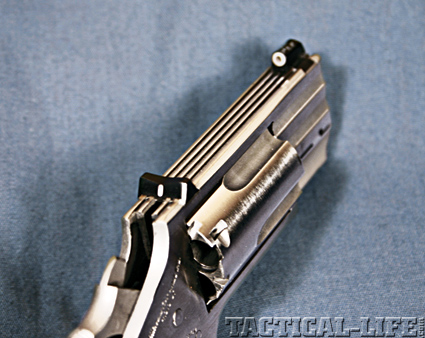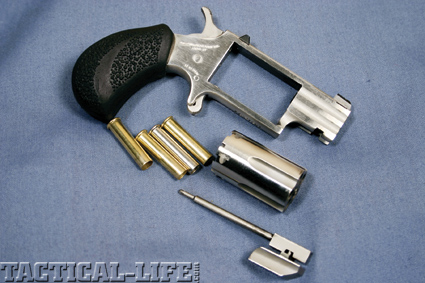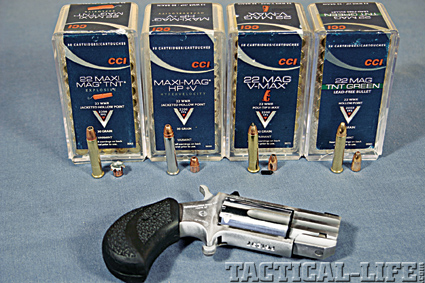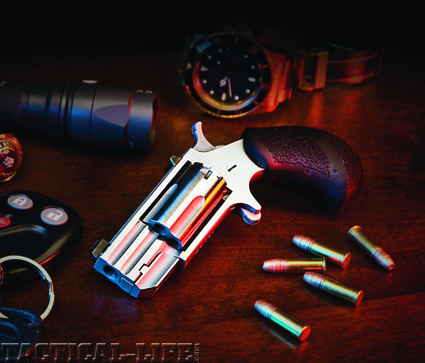NAA’s Pug is a 5-shot, single-action, mini-revolver chambered for the .22 Mag. Its size and weight, plus the X-Press sights make it a perfect back-up gun for deep cover carry. With an available conversion cylinder, the Pug is also capable of firing .22 LR.
About 1971 an outfit came along called Rocky Mountain Arms who began to produce a mini-revolver that was smaller than anything available at the time. It was designed by Dick Casull, a name that will ring a bell with older, more experienced shooters, and it was only 3.5 inches long and chambered for the .22 Short rimfire cartridge. Before too long, this company morphed into North American Arms (NAA), which was later purchased by Sandy Chisholm, who serves as company president to this day. Over the years NAA has greatly expanded the mini-revolver line and added other innovative products like the Guardian semi-automatic pistols. These diminutive handguns have always been quality products and serve well in the role of back-up gun or even back-up to the back-up. Their size and weight, especially the smaller models lend themselves to deep concealment and become that “last ditch” defense when the primary or even secondary firearm is lost, damaged or runs dry and there’s no time to reload or escape.
In the past I have used several NAA products like the Guardian in .32 ACP and the .22 Mag mini-revolvers, which I especially liked to carry with the holster grip accessory that replaces the grip and allowed you to carry the little wheel-gun like a clip-on folding knife. I was more than a little interested when in September 2007 NAA announced the Pug in .22 Mag. I always tended to agree with the late, great Bill Jordan, who in his well-known book No Second Place Winner thought the .22 Mag in a short-barreled revolver would be a wicked little weapon. To me the Pug is just that small, but kind of nasty looking befitting its name. I decided to test one out and see just what kind of performance I would get from a micro-barrel, midget-sized .22 Mag.
Advertisement — Continue Reading Below
Gun Details
The Pug, unlike the other NAA mini-revolvers is what their website describes as “squat and sturdy” like the namesake dog. While the regular mini-five-guns have a tiny round barrel and exposed cylinder pin, the Pug has a heavy 1-inch barrel that is square shaped and fluted with a built-in housing that blends into the barrel with the cylinder pin release modeled after the design first seen on the Black Widow mini-revolvers. This system allows you to pull down and twist a locking lug that frees the cylinder pin so it can be rapidly removed for reloading. The bigger parts associated with this system are easier to grasp and work with when the stress is on and precise motor movements are much more difficult. This barrel gives the little handgun a look that belies its 6.4 ounces unloaded weight.
If you are unfamiliar with NAA mini-revolvers, they are all single-action. They are very reminiscent of the vest pocket pistols of the 19th Century and have what is called a “spur” trigger—there is no triggerguard, just a spur built into the frame to give the trigger some protection. Both the hammer spur and the trigger tip are serrated for better thumb and finger purchase. Another feature that reminds me of cap & ball revolvers of the 1850’s and 1860’s are the slots at the rear of the cylinder between the chambers. These slots are there to provide a secure place to rest the hammer nose/firing pin, other than on the cartridge rim itself, to prevent accidental discharges. Like lots of small handguns from by-gone days, the NAA Pug requires that the cylinder be removed in order to load or unload it. It is both simple and relatively fast, with a little practice. The cylinder pin can also be used to push a stuck case out if need be. Of course with this type of gun and in the kind of situation where it might be employed, you will more than likely only use the 5 rounds available, so a fast reload is probably “not in the cards.”
One big advantage the NAA Pug has over its 19th Century predecessors is its all 17-4 ph stainless steel construction. A hide-out gun can wind up in a lot of different places, some that cause exposure to corrosive body fluids or moisture. The old-timers had to make sure their blued or nickel-plated derringers or boot guns were free from rust and frequently cleaned, which is not the case with the NAA Pug, you can carry it almost anywhere you can hide a small handgun and not worry a whole lot about it collecting rust until you have had the opportunity clean it up. The sample gun also came with “Magnum” grips, made of rubber and pebble grained on the surface for a secure grip. They offer a lot better control when firing the .22 Mag loads in the Pug and are not slippery like the laminated wooden grips that come standard on the NAA mini-revolvers.
Advertisement — Continue Reading Below

NAA Pug comes equipped with fixed Xpress sights. The front sight may either be a white-dot type or a tritium night sight. Note the firing pin on the hammer nose and the notches between the chambers on the rear of the cylinder for it to rest in.
While the NAA Pug is a true “Belly Gun” which means you push it into the belly of your assailant and pull the trigger. It comes with a set of sights that will allow you to take a more precise shot if the situation calls for it. The topstrap/barrel rib is deeply serrated and dovetailed on the front and rear for the XS Sight System it is equipped with. The rear sight is an Xpress type with a shallow V-notch highlighted by a white bar at the bottom center of the V and the front is a big white dot blade or an optional tritium dot night sight. If you have to make a shot in dimly lit conditions, that is far enough where a rough aim is necessary, the glowing front sight will allow you to get in the vicinity before you pull the trigger. If you have the time and the light, the sight setup is good enough for something more precise and point of impact is very important with a small caliber gun.

To load or unload the Pug, a lug located below the barrel is turned and pulled downward, which frees the cylinder pin to be removed. The cylinder is then popped out and empties are extracted or fresh live cartridges added.
Advertisement — Continue Reading Below
Extras
A feature I am especially enamored with in regards to the Pug is the optional conversion cylinder in .22 LR. This cylinder is as long as the .22 Mag cylinder so that it will work in the Pug, but is chambered for the shorter .22 LR cartridge. A box of .22 Mag cartridges retail will run you at least $17 or more and you can do a heck of a lot more shooting with the little gun if you have the optional .22 LR cylinder. As you can buy a box of .22 LR cartridges at about a fourth of the price of .22 Mag ammo, the optional cylinder will pay for itself very quickly and allow you to do a lot more practice with the Pug. Practice is absolutely necessary with one of these little guns, so the more you can afford to do the better. You want to be able to present the gun from its hiding place and bring it to bear; cocking the hammer, starting your trigger squeeze and if necessary, getting a flash sight picture as fluidly as possible. Making this operation second nature will take a lot of rounds, so I’d invest in the .22 LR cylinder.
One other accessory for the NAA Pug that I would highly recommend is one of the holsters that NAA now offers. My personal preference is the HPT-PUG model, which is an open-top pocket holster with a pouch built in that will hold five extra cartridges. This is an all-leather holster, wet-molded to the gun, and the cartridge pouch has a flap secured by a snap. It was designed by the legendary Thad Rybka who has been making holsters since 1959, and at a price of only $30 is well worth it. This is the perfect setup for a backup gun and I have been carrying my sample NAA Pug for almost two years now in this holster, so you don’t have to even ask me if I’m satisfied with it.
Range Time
Although the .22 Mag was introduced by Winchester in 1959, hence the formal name .22 Winchester Magnum Rimfire (WMR), I have been a fan of the cartridges that CCI makes in this caliber for many years. CCI was the first to make a “hyper-velocity” .22 Mag cartridge with a 30-grain rather than a 40-grain bullet and recently they have come up with a number of loads that would seem to have defensive applications. I selected five different CCI .22 Mag cartridges to test in the NAA Pug. The first was the 22 Maxi-Mag HP +V, the oldest of the hyper-velocity loads tested. It has a 30-grain copper-plated bullet with a pear-shaped hollow point for fragmentation and like the other CCI .22 Mag rounds is meant primarily for varmint hunting. Next was the 22 Maxi-Mag TNT, which features a 30-grain bullet with Gold Dot JHP technology for explosive performance. Then there was the .22 Mag V-Max with a 30-grain jacketed bullet with a polymer tip for a higher ballistic coefficient and explosive striking effect. All three of the aforementioned rounds have a factory test barrel (rifle-length) velocity of 2,200 feet per second (fps). The newest load is the .22 Mag TNT Green, which features a 30-grain lead-free HP bullet at a factory listed velocity of 2050 fps. It also boasts explosive impact and great accuracy potential, besides being more environmentally friendly I suppose. Last I included the standard .22 Mag Maxi-Mag 40-grain FMJ load. CCI doesn’t make this load anymore and this box has been in my ammo locker for years. The solids are good for edible small game and also offer deeper penetration.
Advertisement — Continue Reading Below
Of course factory ballistics are one thing, what I wanted to know was how much velocity was I going to get out of a 1-inch barrel? My regular chronograph was acting up the day of the test, so I borrowed a Shooting Chrony chronograph to measure the velocities from the .22 Mag NAA Pug mini-revolver. I certainly was not expecting Mach speeds out of a micro-barrel, but was surprised when some of the hyper-velocity loads produced well over 1,000 fps. The hottest load seemed to be the .22 Maxi-Mag HP +V which recorded the highest velocity of 1,030 fps. In contrast, I ran a Winchester Super-X .22 LR HP (Power Point, 40-grain bullet) through the Pug and the average velocity was only 685 fps.
As the NAA Pug is the last handgun I would choose for the target range, I wasn’t going to do the same type of accuracy test that I would for a full-size, longer barreled pistol or revolver, but I did want to see what kind of accuracy potential it did have just in case I have to make that eye-socket shot from a couple of arms-lengths away. I put up some Birchwood Casey Big Burst targets about 10 feet and fired a 5-shot group with each of the five CCI .22 Mag loads. The first cartridge loaded up was the older Maxi-Mag with the 40-grain FMJ bullet. I leveled the Pug at the target using a two-handed hold and aimed dead-on, cocking the hammer and pressing back on the trigger. The first shot went 2 inches over the X-ring about 11 o’clock, so I decided that a 6 o’clock hold on the X-ring was my best bet. It was and the next 4 rounds impacted in the little orange circle. I did a repeat with the other four CCI loads and most impacted in the X-ring with none going outside of what we’ll call the 10-ring. I was impressed to say the least.
Next, I put up a Birchwood Casey B-27 silhouette target to try my hand at that quick eye-socket shot I alluded to earlier. Here is where that practice pays off. I loaded the NAA Pug with .22 Mags, put it in the pocket holster, and then put the holstered gun in my right hand trouser pocket. I then proceeded to draw and fire from a distance of a couple of arm-lengths, strong-hand-only. The primary reason for this one-handed shooting was that the holster tends to come out of the pocket with the gun still attached and the support hand is used to quickly peel it off the weapon. I was able to draw and trigger that first shot in around 3.5 seconds and my times went down just over a second with some practice. That is not lightning fast by any means, but you aren’t exactly carrying this gun in a quick-draw rig either, so know in advance it will take some time to get into action.
Advertisement — Continue Reading Below

Of the four CCI .22 Mag test loads with expanding bullets, only the .22 Maxi-Mag TNT, with its Gold Dot technology JHP bullet, opened up with a classic “mushroom.” It penetrated 3 water bags and lodged in #4 for about 10 inches of penetration; the others displayed no expansion.
The final test was to see what kind of bullet expansion I might get with the .22 Mag expanding bullet loads from CCI. I set up my “Fackler Box” and using one gallon ziplock baggies, I filled them with water and put a dozen of them front to rear inside the box. I was hoping the bullets would not take some erratic path once they hit the water filled, heavy plastic bags and my luck held. I fired each load from the NAA Pug into the box, the first was the .22 Maxi-Mag TNT. As water gurgled out of the bags, I removed them one by one from front to rear and found that the bullet had penetrated 3 bags completely and remained in the 4th bag. The bullet expanded perfectly and gave about 10 inches of penetration. All of the other bullets just did not expand at all. The .22 Maxi-Mag HP +V made it into bag #7 for about 16 inches of penetration as did the .22 Mag V-Max. Bag #5 stopped the .22 Mag TNT Green for about 12 inches of penetration, the polymer tip was found in the bottom of bag #3. This round tore the biggest hole in the bags of any of them. I don’t think I have to tell you which load I would choose to carry in the NAA .22 Mag Pug. I was impressed with the Gold Dot HP bullet of the .22 Maxi-Mag TNT it worked just like I have come to expect the larger bore GDHP rounds and I might mix load the cylinder with this cartridge and maybe a couple of chambers over, a more penetrative round like the .22 Mag V-Max.
Final Notes
During all my testing the NAA Pug went “bang” every time I pulled the trigger. For a mini-revolver it is very accurate and easy to control in rapid fire due to the rubber grips it is fitted with. The sights are easy to see and really help if you have to make a precision shot, plus they are fairly well regulated. For my money, I think you would have to go a long way to find a better deep-cover back-up gun than the NAA .22 Mag Pug. Find out more at northamericanarms.com or call 800-821-5783.
Advertisement — Continue Reading Below























